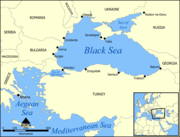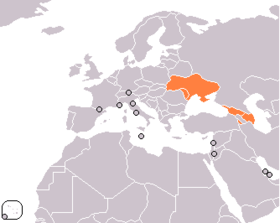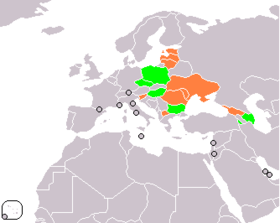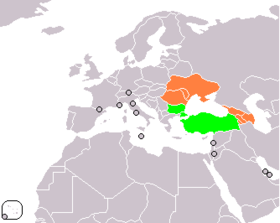Black Sea
2007 Schools Wikipedia Selection. Related subjects: General Geography
The Black Sea is an inland sea between southeastern Europe and Anatolia that is actually a distant arm of the Atlantic Ocean by way of the Mediterranean Sea. It is connected to the Mediterranean by the Bosporus and the Sea of Marmara, and to the Sea of Azov by the Strait of Kerch.
There is a net inflow of seawater through the Bosporus, 200 km³ per year. There is an inflow of freshwater from the surrounding areas, especially central and middle-eastern Europe, totalling 320 km³ per year. The most important river entering the Black Sea is the Danube. The Black Sea has an area of 422,000 km² and a maximum depth of 2210 m.
Countries bordering on the Black Sea are Turkey, Bulgaria, Romania, Ukraine, Russia, and Georgia. The Crimean peninsula is a Ukrainian autonomous republic.
Important cities along the coast include: Istanbul, Burgas, Varna, Constanţa, Yalta, Odessa, Sevastopol, Kerch, Novorossiysk, Sochi, Sukhumi, Poti, Batumi, Trabzon, Samsun and Zonguldak.
Name
Modern names of the Sea are universally translations of Black Sea, including Greek Μαύρη θάλασσα, Bulgarian Cherno more (Черно море), Georgian Shavi zghva (შავი ზღვა), Laz Ucha Zuğa, or simply Zuğa 'Sea', Romanian Marea Neagră, Russian Chyornoye More (Чёрное море), Turkish Karadeniz, Ukrainian Chorne More (Чорне море), Ubykh /ʃʷaʤa/. This name cannot be traced to an earlier date than the thirteenth century, but there are indications that it may be considerably older, cf. below.
Strabo's Geography (1.2.10) reports that in antiquity the Black Sea was often just called "the Sea" (pontos), just like Homer was often simply called "the Poet". For the most part, Graeco-Roman tradition refers to the Black Sea as the 'Hospitable sea' Euxeinos Pontos (Εὔξεινος Πόντος). This is a euphemism replacing an earlier 'Inhospitable Sea' Pontos Axeinos, first attested in Pindar (early fifth century BCE). Strabo (7.3.6) thinks that the Black Sea was called inhospitable before Greek colonization because it was difficult to navigate, and because its shores were inhabited by savage tribes, and that the name was changed to hospitable after the Milesians had colonized, as it were making it part of the Greek civilization. It is, however, likely that the name Axeinos arose by popular etymology from an Iranian axšaina- 'dark'; the designation Black Sea would, after all, go back to Antiquity. The motive for the name may be an ancient assignment of colors to the direction of the compass, black referring to the north, and red referring to the south. Herodotus on one occasion uses Red Sea and Southern Sea interchangeably. Cf. Schmitt 1996.
Another possible explanation comes from the colour of the Black Sea's deep waters. Being further north than the Mediterranean Sea and much less saline, the microalgae concentration is much more rich, hence the dark colour. Visibility in the Black Sea is on average approximately five meters (5.5 yd), as compared to up to thirty-five meters (38 yd) in the Mediterranean. The water however is as blue as any other sea on bright, clear days.
One Bulgarian understanding of the name is that the sea used to be quite stormy. Some sources stipulate that that goes back to the time of Noah's Ark. The Black Sea deluge theory is based on that idea.
Geology and bathymetry
The Black Sea forms an enclosed basin, located between south-eastern Europe and Asia Minor. The basin was formed during the Miocene orogenies which uplifted the mountain ranges and divided the ancient Tethys Ocean into several brackish basins, including the Sarmatic Sea. The Caspian, Azov, Aral and Black Seas are the remnants of this evaporated basin.
The basin is divided into two sub-basins by a convexity extending south from the Crimean peninsula. The north-west of the basin is characterized by a relatively large shelf up to 190 km wide, which has a relatively shallow apron with gradients between 1:40 and 1:1000. The southern edge around Turkey and the eastern edge around Georgia however, are typified by a shelf that rarely exceeds 20km in width and an apron that is typically 1:40 gradient with numerous submarine canyons and channel extensions. The Euxine abyssal plain in the centre of the Black Sea reaches a maximum depth of 2,206m just south of Yalta on the Crimean peninsula. The basin is connected to the Mediterranean Sea via the Turkish Straits System (TSS) in the south-west, which includes the Bosporus and Dardanelles straits and the Sea of Marmara. The Black Sea is connected to the Sea of Azov in the north-east via the Kerch straits.
Hydrology and hydrochemistry
The Black Sea is the world’s largest meromictic basin, with 90% of its volume occupied by anoxic waters. The current hydrochemical configuration is primarily controlled by basin topography and fluvial inputs, which result in a strongly stratified vertical structure and a positive water balance. The upper layers are generally cooler, less dense and less salty than the deeper waters, as they are fed by large fluvial systems, whereas the deep waters originate from the warm, salty waters of the Mediterranean. This influx of dense water from Mediterranean is balanced by an outflow of fresher Black Sea surface-water into the Marmara Sea, maintaining the stratification and salinity levels.
The surface water has an average salinity of 18-18.5 ppt and contains oxygen and other nutrients required to sustain biotic activity. These waters circulate in a basin-wide anti-cyclonic shelfbreak gyre known as the Rim Current which transports water round the perimeter of the Black Sea. Within this feature, two smaller cyclonic gyres operate, occupying the eastern and western sectors of the basin. Outside the Rim Current, numerous quasi-permanent coastal eddies are formed due to upwelling around the coastal apron and ‘wind curl’ mechanisms. The intra-annual strength of these features is controlled by seasonal atmospheric and fluvial variations. Sea Surface Temperature of the surface waters varies seasonally from 8°C to 30°C.
Directly beneath the surface waters the Cold Intermediate Layer (CIL) is found. This layer is composed of cool, salty surface waters, which are the result of localised atmospheric cooling and decreased fluvial input during the winter months. The production of this water is focussed in the centre of the major gyres and on the NW shelf and as the water is not dense enough to penetrate the deep waters, isopycnal advection occurs, dispersing the water across the entire basin. The base of the CIL is marked by a major thermocline, halocline and pycnocline at ~100-200m and this density disparity is the major cause of deep-water isolation.
Below the pycnocline, salinity increases to 22-22.5 ppt and temperatures rise to ~8.5°C. The hydrochemical environment shifts from oxygenated to anoxic, as bacterial decomposition of sunken biomass utilises all of the free oxygen. Certain species of extremophile bacteria are capable of using sulfate (SO42−) in the oxidation of organic material, which leads to the creation of hydrogen sulphide (H2S). This reacts with seawater to produce sulfuric acid (H2SO4). This enables the precipitation of sulfides such as iron-sulphides like pyrite, greigite and iron-monosulphide as well as the dissolution of carbonate matter such as Calcium carbonate (CaCO3) found in shells. Organic matter, including anthropogenic artefacts such as boat hulls, are well preserved. During periods of high surface productivity, short-lived algal blooms cause organic rich layer known as sapropels to occur. Another danger to people posed by the anoxic layer could come from a small asteroid's impact into the Black Sea. Recently modelling shows there is a significant threat to life for people living on the sea's shore. SEE: R.D. Schuiling, R.B. Cathcart, V. Badescu, D. Isvoranu and E. Pelinovsky, "Asteroid impact in the Black Sea. Death by drowning or asphyxiation?", Natural Hazards (October 2006) DOI: 10.1007/s11069-006-0017-7.
Mediterranean connection during the Holocene
While it is agreed that the Black Sea has been a freshwater lake (at least in upper layers) with a considerably lower level during the last glaciation, its postglacial development into a marine sea is still a subject of intensive study and debate. There are catastrophic scenarios such as put forward by William Ryan and Walter Pitman as well as models emphasizing a more gradual transition to saline conditions and transgression in the Black Sea.
They are based on different theories about the level the freshwater lake had reached by the time the Mediterranean Sea was high enough to flow over the Dardanelles and the Bosporus. On the other hand, a study of the sea floor on the Aegean side shows that in the 8th millennium BC there was a large flow of fresh water out of the Black Sea ( New Scientist, 4 May 2002, p. 13).
In a series of expeditions, a team of marine archeologists led by Robert Ballard identified what appeared to be ancient shorelines, freshwater snail shells, drowned river valleys, tool-worked timbers, and man-made structures in roughly 300 feet (100 m) of water off the Black Sea coast of modern Turkey. Radiocarbon dating of freshwater mollusk remains indicated an age of about 7,000 years.
Deluge theory
In 1997, William Ryan and Walter Pitman from Columbia University published a theory that a massive flood through the Bosporus occurred in ancient times. They claim that the Black and Caspian Seas were vast freshwater lakes, but that about 5600 BC, the Mediterranean spilled over a rocky sill at the Bosporus, creating the current communication between the Black and Mediterranean Seas. Subsequent work has been done both to support and to discredit this theory, and archaeologists still debate it. This has led some to associate this catastrophe with prehistoric flood myths.
History
The steppes to the north of the Black Sea have been suggested as the original homeland ( Urheimat) of the speakers of the Proto-Indo-European language, (PIE) the progenitor of the Indo-European language family, by some scholars (see Kurgan; others move the heartland further east towards the Caspian Sea, yet others to Anatolia).
The land at the eastern end of the Black Sea, Colchis (now Georgia), marked for the Greeks an edge of the known world.
Holiday resorts and spas
|
|
1 Abkhazia has been a de facto independent republic since 1992, although remains a de jure autonomous republic of Georgia.
Regional organizations
See also the Balkans Regional organizations and Post-Soviet Regional organizations









